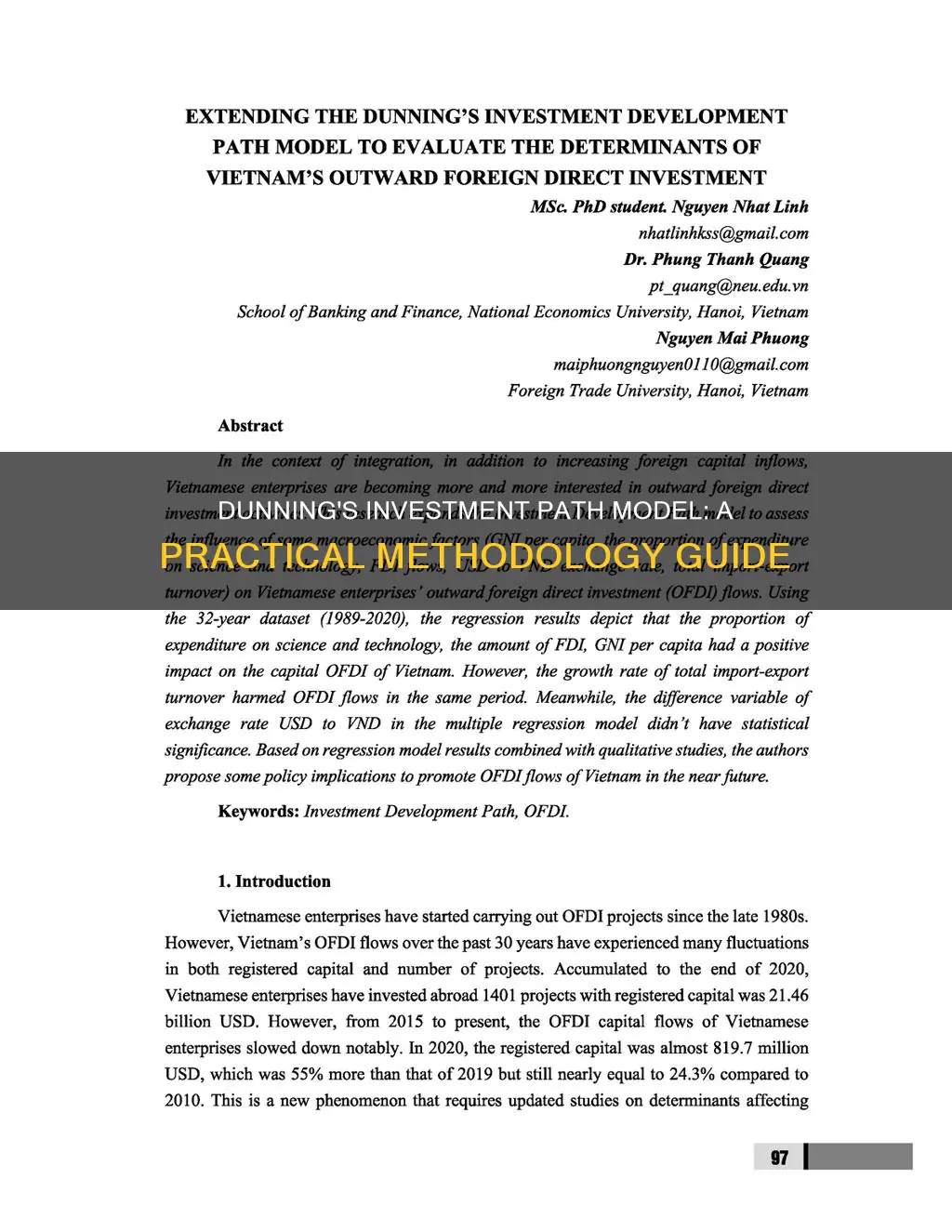
The Investment Development Path (IDP) theory, introduced by John H. Dunning, is a dynamic approach to understanding the relationship between foreign direct investment (FDI) and a country's level of development. The theory posits that countries go through five stages with respect to their net outward investment positions as they progress, with the level of development measured by gross domestic product (GDP) and net outward investment (NOI) calculated as the difference between outward and inward investment stocks. This theory has been applied to various countries and sectors, including agriculture, to guide firms seeking to expand internationally and inform economic policies. The IDP framework is particularly useful for analysing outward foreign direct investment (OFDI) and can be extended to include institutional factors and other variables such as human assets development.
| Characteristics | Values |
|---|---|
| Stages | 5 |
| Focus | Net outward investment positions of countries |
| Level of development measurement | Gross domestic product (GDP) |
| NOI measurement | Difference between outward and inward investment stocks |
| IDP structure | Non-linear fluctuation approach |
| IDP research methodology | Geographic analysis of FDI |
| IDP analysis | Economic factors, institutional factors, cultural similarity between countries |
| Modes of FDI | Greenfield investment, acquisition mode, joint venture |
| FDI motives | Resource-seeking, market-seeking, efficiency-seeking, strategic asset-seeking |
| FDI ownership advantages | Proprietary information, branding, copyright, trademark, patent rights, skills |
| FDI location advantage | Comparative advantage of performing functions within a particular nation |
| FDI internalization advantage | In-house production, outsourcing |
What You'll Learn
- The impact of institutional factors on outward foreign direct investment (OFDI)
- The role of home country institutions in OFDI
- The relationship between a country's net outward investment position and its level of development
- The use of IDP to analyse foreign divestment
- The application of IDP to specific countries or regions

The impact of institutional factors on outward foreign direct investment (OFDI)
Dunning's Investment Development Path (IDP) theory suggests that countries go through five stages of development with respect to their net outward investment positions. The theory has been extended to incorporate the role of home country institutional determinants in explaining outward foreign direct investment (OFDI).
Institutional factors play a crucial role in influencing OFDI. For instance, China's shift from restriction to liberalization and active support for OFDI resulted in a surge of investment flows, particularly after 2008. Similarly, institutional reforms and competition policies are essential in explaining OFDI from Central and Eastern European countries.
The impact of institutional factors on OFDI is also evident in the case of Thailand and Malaysia, where foreign direct investment policies and infrastructure development have influenced the competitiveness of their electric vehicle sectors. Additionally, institutional factors, such as intellectual property protection and marketization levels, have been found to moderate the relationship between OFDI and green total factor energy efficiency in China.
Furthermore, the marketization level, reflecting the resource allocation efficiency of a region, influences the impact of OFDI on green total factor productivity. Regions with lower marketization levels tend to experience a stronger promotion effect of OFDI on green total factor productivity.
Overall, institutional factors significantly shape the trajectory of OFDI, and their consideration is crucial for understanding and influencing investment flows.
Invest Wisely: Financial Freedom Through Fiscally-Minded Strategies
You may want to see also

The role of home country institutions in OFDI
Dunning's Investment Development Path (IDP) theory claims that countries go through five stages with respect to their net outward investment positions as they develop. The theory can be used to explain the role of home country institutions in outward foreign direct investment (OFDI).
Home country institutions are crucial in understanding the shape of human interaction and the strategies and interactions of firms in the international environment. The institutional quality of a country is closely related to its growth and economic development. The set of institutions in a specific economy is called the institutional framework.
The internationalization of economies is driven by specific industry conditions or business-specific differences, but also by the institutions that exist as background conditions. The home market's structural environment can either support or constrain decisions for foreign expansion.
There are two structural forces that influence firms' OFDI decisions from emerging markets. Firstly, in emerging markets, institutional environments are often troubled by a poor defence of property rights, insufficient laws and judicial regulation, and an unpredictable political climate. These inefficiencies affect the availability and quality of factor inputs and thus limit companies' production pursuits. As a result, internationalization is a reaction to escaping the domestic market's stifling bureaucratic climate. Secondly, emerging market governments promote local companies through a combination of formal and informal incentives to seek international expansion. Despite their lack of clear ownership benefits, such institutional support helps emerging market firms resolve foreign liability and seek international expansion.
Overall, the institutional environment creates two streams of OFDI: leverage and escapism. Firms with strong institutional support are more likely to invest abroad, while those facing institutional hazards may seek to escape their home country's poor institutional climate.
Chatbot Investing: Smart Money Moves with AI Assistance
You may want to see also

The relationship between a country's net outward investment position and its level of development
The Investment Development Path (IDP) theory, proposed by J.H. Dunning, claims that a country's net outward investment (NOI) position changes as it develops. The level of development is measured by gross domestic product (GDP), while NOI is measured by the difference between outward and inward investment stocks. The relationship between a country's NOI and its level of development can be defined by a five-stage process:
Stage 1: At this stage, a country is an importer of capital, with inward investment exceeding outward investment. This is typical of less developed countries with low GDP.
Stage 2: As a country develops, it may reach a point where inward and outward investment are roughly equal. This indicates a more balanced flow of investment, although the country may still be a net importer of capital.
Stage 3: This is the turning point where a country transitions from being a net importer to a net exporter of capital. Outward investment begins to exceed inward investment.
Stage 4: The country is now a net exporter of capital, with outward investment significantly exceeding inward investment. This stage is often associated with higher economic growth and development.
Stage 5: In the final stage, a country may experience a slowdown in outward investment growth while inward investment catches up. This can occur due to various factors such as changing economic conditions, geopolitical tensions, or a shift in global sentiment.
The IDP theory has been applied to various countries, including Kazakhstan, Poland, China, and Vietnam, to understand their investment trajectories and develop appropriate policies to boost their economic development.
When using Dunning's investment path model as a methodology, it is essential to consider the dynamic relationship between foreign direct investment (FDI) and a country's level of development. This involves analyzing how patterns in FDI respond to changes in the ownership, location, and internalization advantages of firms and countries. Additionally, institutional factors, such as competition policy and overall institutional reforms, play a crucial role in influencing outward FDI.
A Beginner's Guide to ETF Investing with Fidelity
You may want to see also

The use of IDP to analyse foreign divestment
The Investment Development Path (IDP) theory, as introduced by John H. Dunning, posits that countries go through five stages of development with respect to their net outward investment positions. This theory has been used to understand the dynamic relationship between foreign direct investment (FDI) and a country's level of development.
Foreign divestment, on the other hand, refers to the withdrawal of investments by multinational enterprises (MNEs) from a particular country or region. While the IDP theory primarily focuses on FDI, it can also be applied to analyse foreign divestment.
For instance, a study on Greece's integration development path examined foreign divestment within the context of regional integration. The study found that despite the positive economic development of Greece, there was still considerable manufacturing divestment during the transition from protectionism to regional integration. This highlights how foreign divestment can occur even in a growing economy, which contradicts the linear progression suggested by the IDP theory.
Another example is a study on divestment by Brazilian multinational firms, which adopted Dunning's IDP theory to investigate the impact of institutional characteristics of the home country on emerging market multinational enterprises' divestment. The study found that receiving government financial support to establish foreign subsidiaries could lead to higher rates of divestment, while having market-supporting institutions in the home country decreased the likelihood of foreign divestment.
In conclusion, while the IDP theory is a useful framework for understanding the relationship between FDI and a country's development, it is important to also consider foreign divestment. By analysing foreign divestment through the lens of the IDP theory, we can gain insights into the specific conditions and factors that influence investment decisions, such as economic and political friction, institutional characteristics, and levels of firm interaction.
Investing Cash: Strategies for Maximizing Your Money's Potential
You may want to see also

The application of IDP to specific countries or regions
Dunning's Investment Development Path (IDP) model has been applied to various countries and regions, offering insights into their economic development and foreign direct investment (FDI) dynamics. Here are some specific examples of its application:
Kazakhstan
Kazakhstan's integration into the global economy and its transitional economy have been analysed through the lens of the IDP model. The country's net external investment position was studied, and it was found to be in the second stage of its investment development path. This research is significant for economic policies and teaching economic disciplines.
China
China's economic trajectory and integration into global value chains (GVCs) have been attributed to its continuous inflow of FDI, in line with the IDP theory. China's role as a leading trading partner for developed countries and its impact on global production have been examined, especially in light of recent geopolitical tensions and the COVID-19 pandemic.
Vietnam
The IDP theory has been applied to Vietnam's agricultural sector, with a focus on determining the country's position in the investment development path. The findings suggest that Vietnam's agricultural sector requires policies to boost FDI performance and move to higher stages of the IDP.
Central and Eastern European Countries (CEECs)
The IDP model has been augmented with institutional theory to explain outward FDI from CEECs. This research highlights the importance of accounting for home country institutional factors, such as competition policy and overall institutional reforms, in understanding FDI outflows from these countries.
Poland
Poland's accession to the European Union and the global financial crisis have been analysed using the IDP framework. The impact of these events on Poland's economic development and FDI flows was assessed, with a focus on the third and fourth stages of the model, representing innovation-driven and knowledge-based economies, respectively.
Baltic Sea Region (BSR) States
The IDP model has been applied to four BSR states: Estonia, Latvia, Lithuania, and Poland. Despite sharing a common historical path, these countries exhibited differences in economic growth and their roles as importers of capital. The analysis revealed that Poland and Estonia were progressing faster in their investment development paths compared to Latvia and Lithuania.
Smart Ways to Invest Your $325,000 Windfall
You may want to see also
Frequently asked questions
Dunning's Investment Path Model (IDP) claims that countries go through five stages with respect to their net outward investment positions as they develop.
The model defines a country's level of development by its gross domestic product (GDP) and net outward investment (NOI) by measuring the difference between outward and inward investment stocks.
Policymakers can use the model to identify a country's stage in the investment development path and implement appropriate policies to boost foreign direct investment performance and move the country forward to higher stages of the investment path.
While the model provides insights into the relationship between foreign direct investment and a country's level of development, it primarily focuses on investment and development and does not adequately address divestment.







